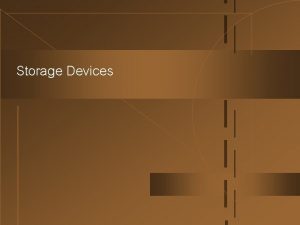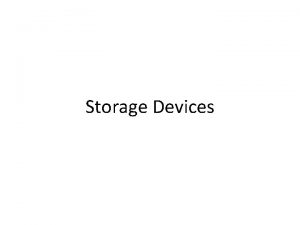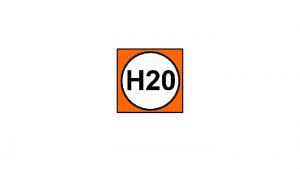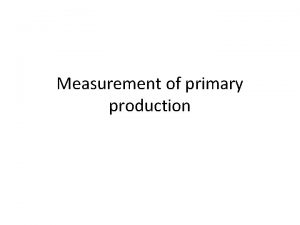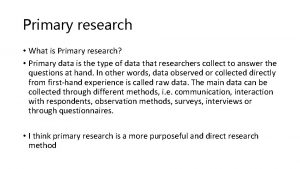Storage The two types of storage Primary Storage

























- Slides: 25

Storage The two types of storage: Primary Storage Secondary Storage

Primary storage is also called Main Memory


RAM ROM Random Access Memory ü Volatile- data lost if computer switched off ü Short term storage of data Read Only Memory q Non-volatile- data remains when computer is switched off q Long term / permanent storage of data Primary Storage

Difference between RAM and ROM RAM- is only filled after a computer has been turned on and given something to do. ROM- holds data and instructions necessary for starting up the computer when it is switched on.

Next session…. Secondary Storage Next Session

Secondary Storage Is needed to store data and programs needed for later use. Types of Secondary storage devices:

Magnetic Disks Floppy disk Advantages: 1)cheap to buy 2)useful in transferring 5. 25” data Disadvantages: 1)very unreliable at times 3. 5’’

Magnetic Disks Hard Disk Advantages: 1)very fast to data access since data can be accessed directly

Magnetic Tape Advantage: Disadvantages: 1)it is small data 2)It is cheap 3)It can store lots of data 1)accessing is very slow

Optical Disk Compact Discs (CD) and Digital Video Discs (DVD) Advantages: 1)Can store lots of data (more than floppy)

Flash Memory Flash memory is a type of constantly powered nonvolatile memory that can be erased and reprogrammed in units of memory called blocks Types: USB Flash drive / pen drive USB stands for Universal Serial Bus

Memory Card A memory card or flash card is an electronic flash memory data storage device used for storing digital information What is SD? Secure Digital (SD) is a nonvolatile memory card used extensively in portable devices, such as mobile phones, digital cameras, GPS navigation devices, handheld consoles,

Secondary storage is also known as Backing Store or Auxiliary Storage

Things to know: ØIt is always slower to access data from backing storage than from main memory. q. Data stored in backing storage is permanent so it is NOT lost when the computer is turned off. v. Data stored in main memory is lost when the computer is turned off.

Next class What are the other types of Rom Write notes on the types of ROM

Class Activity Look at the table in your text that lists the storage devices (pages 38 & 39), their storage capacity and advantages and disadvantages. Copy parts of the table into your notebook

Questions What is the difference between CD-R and CD-RW? What is the storage capacity for hard disks measured in? What is the storage capacity for modern flash drives measured in? List the types of magnetic disks.

Components of a hard disk Draw and well labeled diagram for a hard disk showing: sectors, tracks, cylinders, read-write heads, etc

Video How a hard drive works

Complete the following chart Storage Primary RAM ? ? Magnetic tape Hard Disk Optical Disk ? ? ? Memory Card ?

Past Paper Questions Attempt ALL May 2013 Q 3 Jan 2009 Q 2 Jan 2014 Q 3 Jan 2013 Q 3

Access Methods This term is used to refer to the mechanics of locating specific data at a particular place on a storage medium. There are 2 types of access methods: Direct Access Sequential Access

Direct Access This means that you can go directly to a specific piece of data without having to access any other data either before or after the data you want

Sequential Access Means that data is retrieved (accessed) in the order in which it was stored
 Primary storage and secondary storage
Primary storage and secondary storage Secondary storage vs primary storage
Secondary storage vs primary storage Hát kết hợp bộ gõ cơ thể
Hát kết hợp bộ gõ cơ thể Frameset trong html5
Frameset trong html5 Bổ thể
Bổ thể Tỉ lệ cơ thể trẻ em
Tỉ lệ cơ thể trẻ em Gấu đi như thế nào
Gấu đi như thế nào Chụp phim tư thế worms-breton
Chụp phim tư thế worms-breton Bài hát chúa yêu trần thế alleluia
Bài hát chúa yêu trần thế alleluia Các môn thể thao bắt đầu bằng tiếng chạy
Các môn thể thao bắt đầu bằng tiếng chạy Thế nào là hệ số cao nhất
Thế nào là hệ số cao nhất Các châu lục và đại dương trên thế giới
Các châu lục và đại dương trên thế giới Công thức tính độ biến thiên đông lượng
Công thức tính độ biến thiên đông lượng Trời xanh đây là của chúng ta thể thơ
Trời xanh đây là của chúng ta thể thơ Mật thư anh em như thể tay chân
Mật thư anh em như thể tay chân 101012 bằng
101012 bằng độ dài liên kết
độ dài liên kết Các châu lục và đại dương trên thế giới
Các châu lục và đại dương trên thế giới Thể thơ truyền thống
Thể thơ truyền thống Quá trình desamine hóa có thể tạo ra
Quá trình desamine hóa có thể tạo ra Một số thể thơ truyền thống
Một số thể thơ truyền thống Cái miệng bé xinh thế chỉ nói điều hay thôi
Cái miệng bé xinh thế chỉ nói điều hay thôi Vẽ hình chiếu vuông góc của vật thể sau
Vẽ hình chiếu vuông góc của vật thể sau Thế nào là sự mỏi cơ
Thế nào là sự mỏi cơ đặc điểm cơ thể của người tối cổ
đặc điểm cơ thể của người tối cổ Thế nào là giọng cùng tên? *
Thế nào là giọng cùng tên? *



























